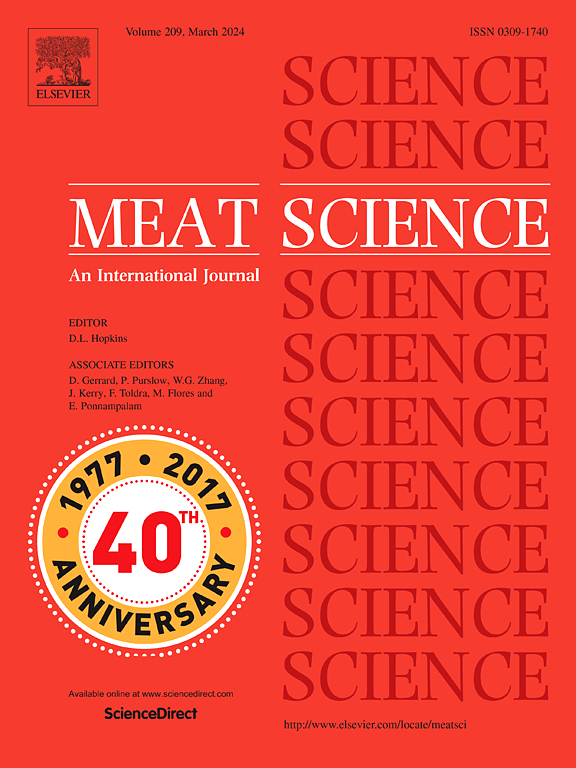对澳大利亚用于预测羔羊胴体成分的屠宰场内双能 X 射线吸收仪扫描设备进行认证。
IF 7.1
1区 农林科学
Q1 Agricultural and Biological Sciences
引用次数: 0
摘要
目前,澳大利亚的六家羊肉屠宰场安装了双能 X 射线吸收仪(DXA)扫描仪,以屠宰场的加工速度运行,通过计算机断层扫描(CT)测定的脂肪率、瘦肉率和骨骼率来预测胴体成分。本研究测试了用于这些 DXA 扫描仪的最新骨骼检测算法。与之前的算法(R2 = 0.51,RMSE = 1.57 %)相比,该算法提高了胴体脂肪率和瘦肉率的预测精度,但最显著的是骨骼率的预测精度(R2 = 0.92,RMSE = 0.61 %)。这是由于在骨骼检测方程中加入了组织厚度,从而改善了含骨像素的分配。在第二项实验中,对这种新算法的预测结果和自动模型校准技术进行了评估,看它们是否能达到 AUS-MEAT 认证的准确度标准,即预测 CT 测定的胴体脂肪率、瘦肉率和骨骼率。DXA 在预测轻型胴体(28 千克)三个重量段的脂肪率(范围为 10.9 % - 37.1 %)、瘦肉率(范围为 49.0 % - 66.2 %)和骨骼率(范围为 11.6 % - 25.0 %)方面达到了这些标准。这项工作使 DXA 获得了认证,使其对胴体成分的预测可用于澳大利亚的绵羊胴体交易。这些预测的准确性远远超过了历史上行业测量 GR 组织深度和热胴体重量所提供的准确性。本文章由计算机程序翻译,如有差异,请以英文原文为准。
Accreditation of in-abattoir Dual Energy X-ray Absorptiometry scanning apparatus to predict lamb carcass composition in Australia
Dual Energy X-ray Absorptiometry (DXA) scanners operating at abattoir processing speeds are currently installed in six sheep meat abattoirs around Australia, predicting carcass composition as estimates of computed tomography (CT) determined fat %, lean %, and bone %. This study tested an updated bone-detection algorithm for these DXA scanners. This algorithm improved the precision of prediction for carcass fat% and lean%, but most notably for bone % (R2 = 0.92, RMSE = 0.61 %), compared to the previous algorithm (R2 = 0.51, RMSE = 1.57 %). This was due to improved allocation of bone-containing pixels, resulting from the inclusion of tissue thickness in the bone-detection equation. In a second experiment, the predictions from this new algorithm, along with an automated phantom calibration technique, were assessed relative to their ability to meet the AUS-MEAT accreditation accuracy standards required for predicting CT determined carcass fat%, lean%, and bone%. The DXA met these standards for predicting fat % (range 10.9 % - 37.1 %), lean % (range 49.0 % - 66.2 %), and bone % (range 11.6 % - 25.0 %), across three weight bands of light carcasses (<22 kg), mid-weight carcasses (22-28 kg), and heavy carcasses (>28 kg). This work allowed for the accreditation of DXA, enabling its predictions of carcass composition to be used for trading sheep carcasses in Australia. The accuracy of these predictions far exceed those provided by the historical industry measure of GR tissue depth, and hot carcass weight.
求助全文
通过发布文献求助,成功后即可免费获取论文全文。
去求助
来源期刊

Meat Science
工程技术-食品科技
CiteScore
12.60
自引率
9.90%
发文量
282
审稿时长
60 days
期刊介绍:
The aim of Meat Science is to serve as a suitable platform for the dissemination of interdisciplinary and international knowledge on all factors influencing the properties of meat. While the journal primarily focuses on the flesh of mammals, contributions related to poultry will be considered if they enhance the overall understanding of the relationship between muscle nature and meat quality post mortem. Additionally, papers on large birds (e.g., emus, ostriches) as well as wild-captured mammals and crocodiles will be welcomed.
 求助内容:
求助内容: 应助结果提醒方式:
应助结果提醒方式:


